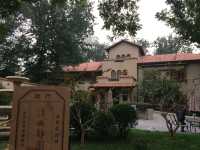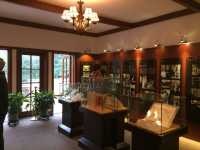Before five o'clock, I could not expect to enter again. As a result, I caught the last bus, stopped entering the garden at five and closed at five-thirty. Tickets I have seen the most intentional ticket design, must point a compliment. Jingyuan was used as a residential building for a long time after liberation, and the photos were in a state of chaos. In recent years, there have been many highlights in interior design and display. Puyi has lived here for several years since he left Beijing for Changchun to establish the puppet Manchuria. If you know Puyi's life very well, you can spend half an hour browsing. It's a pleasure to sit in the yard for more time. In other words, Tianjin Wei's many buildings in the late Qing Dynasty and the early Republic of China are really well preserved.
;
Jingyuan Garden Review
4.7 /53070 Reviews
Popular Destinations
Ipoh Travel | Da Nang Travel | Folkestone Travel | Lido Di Jesolo Travel | Munich Travel | Peak District National Park Travel | Jeddah Travel | Luton Travel | Larnaca Travel | Johor Bahru Travel | Middlesbrough Travel | Paphos Travel | Nice Travel | Kuching Travel | Windermere Travel | Vlore Travel | Alanya Travel | Jiaxing Travel | Bydgoszcz Travel | Famagusta Travel | Sakurai Travel | Narayani Travel | Soufriere Travel | Yla-Pirkanmaa Travel | Moose Jaw Travel | Lodi Travel | Fall River County Travel | Bridgewater Travel | La Jolla Travel | Suihua Travel
Recommended Attractions at Popular Destinations
Bangkok attraction near me | Tokyo attraction near me | Manila attraction near me | Hong Kong attraction near me | Seoul attraction near me | Taipei attraction near me | Los Angeles attraction near me | New York attraction near me | Shanghai attraction near me | Kuala Lumpur attraction near me | Shenzhen attraction near me | Osaka attraction near me | London attraction near me | Singapore attraction near me | Guangzhou attraction near me | San Francisco attraction near me | Beijing attraction near me | Macau attraction near me | Bali attraction near me | Paris attraction near me | Orlando attraction near me | Jakarta attraction near me | Ho Chi Minh City attraction near me | Chicago attraction near me | Phuket attraction near me | Toronto attraction near me | Dallas attraction near me | Istanbul attraction near me | Cebu attraction near me | Seattle attraction near me
Popular Attractions
Bird's Nest (National Stadium) | Awana SkyWay | Birmingham New Street | The West Lake | Shanghai Wild Animal Park | Lime Street Railway Station | Patong Boxing Stadium Sainamyen | Oriental Pearl Radio & Television Tower | Manila Ocean Park | Christin Massage | Guinness Storehouse | BAURARI STADIUM | Zhangjiajie Grand Canyon | Ghibli Park | Dadonghai | Everland | Belfast Castle | Ruposhi Bangla Park | Grand Tour of Switzerland Foto Spot, Bellinzona | Haibargaon Police Station Shiv Mandir | Palomarejos Golf | Lamprey's Garden | MASJID NURUL YAQIN | Breckinridge Park | D Block Park | Queenston Park | Hanumaan Mandir | Mutianyu Great Wall | Aquaria KLCC | The Bund
Popular Travelogues
Bangkok Travelogue | Tokyo Travelogue | Hong Kong Travelogue | Seoul Travelogue | Los Angeles Travelogue | New York Travelogue | Shanghai Travelogue | Kuala Lumpur Travelogue | Shenzhen Travelogue | Osaka Travelogue | London Travelogue | Singapore Travelogue | Guangzhou Travelogue | San Francisco Travelogue | Beijing Travelogue | Macau Travelogue | Bali Travelogue | Paris Travelogue | Ho Chi Minh City Travelogue | Chicago Travelogue | Phuket Travelogue | Toronto Travelogue
Payment Methods
Our Partners
Copyright © 2024 Trip.com Travel Singapore Pte. Ltd. All rights reserved
Site Operator: Trip.com Travel Singapore Pte. Ltd.
Site Operator: Trip.com Travel Singapore Pte. Ltd.




















